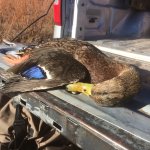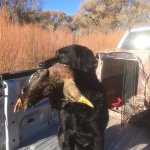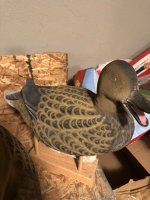I feel my ocd kicking in. Time to order flock. Using Rustoleum as a base/adhesive is a big plus.
You are using an out of date browser. It may not display this or other websites correctly.
You should upgrade or use an alternative browser.
You should upgrade or use an alternative browser.
September workbench
- Thread starter Don Mintz
- Start date
Funny you say this... the magic isnt in the airbrushing, its all the flocking when hunting. Let me back track a little though and say, you certainly are getting a master piece when getting a decoy from Don because his and Calebs artistic ability is just at an outstanding level. His workmanship is some of the best in the game of decoys, especially since it comes from an airbrush gun and not from a brush in hand. There are some things that make it easier, but the fine lines and the ability to add subtle detail, that I see in his work, that really makes me appreciate the level of work he accomplishes. That is the part that is not so easy with an airbrush because of how rustoleum acts coming out of a airbrush gun and what it takes not to get overspray vs getting a nice spray without a plugged tip. Its as much an art to keep the gun running right as it is the ability to lay it down on the decoy correctly. You are spraying a paint, that was intended to be applied to steel, through a metal gun of all metal parts with lots of air trying to dry it while you're trying to keep it flowing. It takes lots of practice, BUT Don has it down perfect!Those are mighty fine without airbrushing. Any self respecting mallard would be proud to be fooled by them.
With ALL that said... I bet you could take the flocked mallards with black heads, gray bodies, and black rumps, paint the bills yellow and hunt over them and kill mallard. Im big on sheen coming off decoys from a distance. Many many times my hunts were done in the first 30 minutes of sun up last year. usually this is the worst on decoys for getting that plastic white sheen off them. Many mornings, I didnt even have to call birds in, they surprised me with wing beats down in the decoys. I know for a fact I wasnt hunting the x either, I was still 300 yards off the x as I couldnt figure out how to hunt such deep water, so I had to settle where I could safely hunt and set decoys. Even then, I truly believe in my heart of hearts, that the flocking and the fact they looked like black silhouettes from a distance, instead of white sheening blobs of flare, is why I had such good results as early as i was having it. I even thought, maybe early season dumb birds, but this behavior went all the way into the final weekends of January. The final weekend we hunted, I hunted with a young kid I mentor, and he was having lots of issues decoying birds down because he pounded it so hard week after week. We only hunted over my fully flocked and they decoyed right in to the spread over and over. He told me he hadnt had birds decoy that good since the opening month of season on that hole. Which then lead him to ask if he could have some of my decoys if I was upgrading poses for this year. I will likely give him 18 of my last season birds as he is a good kid an does waterfowl the right way. need to take care of our next generation.
Like Don even says.... if he was gonna hunt over black jugs, even he would flock those and I couldnt agree more at this point. We always knew flocking was better, it just never stayed on for more than a season when bought from these bigger companies that get everything made in china. At that point it was the same as hunting over plastic decoys. I also didnt know they were using a different system for flocking and it wasnt in the least bit durable for the elements waterfowlers face. Double flock and use the rustoleum, Don is genius for figuring this out.
Thank you both for the help and insight. Flocking is next on the decoy refinishing calendar. I'm gonna try blacks first, then some mallards.
@SJ Fairbank just to give you some comparison, my hens are gray paint with feather brown flocking. I think Don says to use black paint or leather brown paint with feather brown flocking to get that darker color for black ducks. I know the lighting isn’t the best in my shop, but the brown would be too light for black ducks as my birds sit on the bench prior to being airbrushed. The paint under flocking really does make a difference as well. Rustoleum only makes very few colors, might as well buy a quart of each color and play around. Wait til you start mixing and coming up with your own colors. Then it gets real fun. I buy empty quart containers and measure everything out, once I get the color I like, I write down my mixing ratios on the side of the can, so I can always make more later on.Thank you both for the help and insight. Flocking is next on the decoy refinishing calendar. I'm gonna try blacks first, then some mallards.
I assume you mean hen mallards in the first sentence? We paint both sexes of blacks the same, very dark, except the difference in bill color. Your decoys are excellent in any event.@SJ Fairbank just to give you some comparison, my hens are gray paint with feather brown flocking. I think Don says to use black paint or leather brown paint with feather brown flocking to get that darker color for black ducks. I know the lighting isn’t the best in my shop, but the brown would be too light for black ducks as my birds sit on the bench prior to being airbrushed. The paint under flocking really does make a difference as well. Rustoleum only makes very few colors, might as well buy a quart of each color and play around. Wait til you start mixing and coming up with your own colors. Then it gets real fun. I buy empty quart containers and measure everything out, once I get the color I like, I write down my mixing ratios on the side of the can, so I can always make more later on.
Yes hen mallards. I’ve never painted a black duck as I’ve never even seen one. We don’t get blacks or mottled ducks out west, just Mexican mallards. I’m excited to finally get to new species of decoys next off season. Only thing my squiggly artistic hands have created are pintail and mallard thus far. Next year I’ll get a little more wild with things.I assume you mean hen mallards in the first sentence? We paint both sexes of blacks the same, very dark, except the difference in bill color. Your decoys are excellent in any event.
Attachments
Back before working decoys . net was bought and shut down we had several people working with flocking combinations. One guy had an entire board of anything and everything in flocking/paint colors. We probably need to start figuring out some combinations that work for the various colors. I have used grey rustoleum with brown paint and feather brown over it to get a less dark base for mallards, but it's still pretty dark. I've also used it for the back of specks and canada geese. I use leather brown rustoleum under goose grey flocking on the body for a drake wigeon, and paint the head grey with the same grey flocking in the same step so I get a clean transition from body to head. This is how it looks with the paint on and after it's flocked.
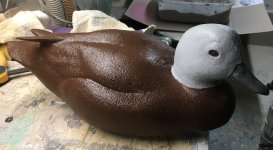
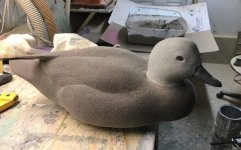
I like the flocking color to be as close as possible to the final appearance I want with minimal airbrushing over it.
This shoveler shows the variety of colors I flocked to be able to get the final result I wanted.
a custom mix of slate blueish grey flocked with goose grey for the shoulder, a dark orangish brown mix flocked with feather brown for the flanks and, feather brown over brown for the wing. I would like a lighter brown color for mallard hens, but still haven't been able to figure that one out, I might try some leather brown with bisque tan over it and see where that goes. Lots of lighter combinations like the wood duck flank I mentioned before were flocked white over a color and that works pretty well. I need to find some scraps and start trying different stuff.
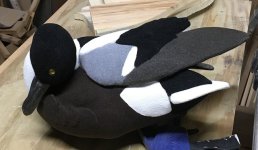

In regards to the discussion about just flocking a decoy a color and not airbrushing. I did that with a pair of wigeon decoys, virtually the same pose, one I flocked all the appropriate colors, but didn't airbrush it. I set them in the decoy spread without mentioning it to our host and asked him if he could pick out the unairbrushed one, he couldn't tell. It's the flocking, not the pretty that makes the difference, but the pretty is kind of fun to do.


I like the flocking color to be as close as possible to the final appearance I want with minimal airbrushing over it.
This shoveler shows the variety of colors I flocked to be able to get the final result I wanted.
a custom mix of slate blueish grey flocked with goose grey for the shoulder, a dark orangish brown mix flocked with feather brown for the flanks and, feather brown over brown for the wing. I would like a lighter brown color for mallard hens, but still haven't been able to figure that one out, I might try some leather brown with bisque tan over it and see where that goes. Lots of lighter combinations like the wood duck flank I mentioned before were flocked white over a color and that works pretty well. I need to find some scraps and start trying different stuff.


In regards to the discussion about just flocking a decoy a color and not airbrushing. I did that with a pair of wigeon decoys, virtually the same pose, one I flocked all the appropriate colors, but didn't airbrush it. I set them in the decoy spread without mentioning it to our host and asked him if he could pick out the unairbrushed one, he couldn't tell. It's the flocking, not the pretty that makes the difference, but the pretty is kind of fun to do.
So a couple more questions:
I recall you guys saying you flock or coat the decoy twice? Is that a base coat of paint, then paint plus flock? Or flock both coats?
Maybe I missed it, but do you mix flock colors in the bucket to get the color you want before applying it? Or is it only a matter of changing base paint color?
Thanks for the widgeon example of how the base color affects the final flock color.
I recall you guys saying you flock or coat the decoy twice? Is that a base coat of paint, then paint plus flock? Or flock both coats?
Maybe I missed it, but do you mix flock colors in the bucket to get the color you want before applying it? Or is it only a matter of changing base paint color?
Thanks for the widgeon example of how the base color affects the final flock color.
I can get pretty wordy to the point of confusion a lot of the time. I'll give the basic steps and then give some technique after.
Step 1. Gloss oil based enamel over the entire decoy except the eyes.
Step 2. As soon as you have applied the paint, sift flocking over the entire surface.
Step 3. After a day of drying, apply another coat of paint according to your final color coverage over the single flocked surface covering it thoroughly.
Step 4. Sift your final flocking color over that second coat of paint.
Additional clarification of the steps.
Step 1. this coat needs to be thorough, but not quite to the point of running. I use rustoleum gloss oil based enamel or Ace Hardware brand which is likely the same source. The flocking needs to be applied immediately after the paint, gloss stays tacky for awhile, but the sooner the better for good adhesion. I have used all the common flocking adhesives, even the ones provided in the flocking kits and nothing works as well as oil based enamel. My very first flocking attempt was with a kit of black that I used on 3 goldeneye, the flocking was coming off on the way home, however we decoyed hundreds of mallards into those three decoys that day right to the water. The magic of black flocking. Sorry I'm a diver hunter lol.
Step 2. I apply flocking with a simple kitchen sieve. I've tried the puff bottles and the air assist guns and nothing is as fast or thorough as the kitchen sieve over a catch tub. I have a paint booth that I do my flocking in, the air flow is relatively low, so it doesn't pull the flocking out of the area aggressively. Most of it will drift back into my tub and recaptured. I cover the entire decoy with the side up I'm concentrating on so when I'm shaking the decoy, I'm shaking it on, not shaking it off. Once I've done the whole decoy, I shake it aggressively and set it aside.
Step 3. The second coat of is a bit different. It will take more paint and flocking. You want to paint the flocked surface thoroughly but not crazy thick, you need to see the fibers evenly in the paint like the wigeon in the previous post. This is where you determine your final base colors for the decoy.
Step 4. When I flock on the second round. I bump and walk the flocking over the decoy after it's sifted to settle the flocking in. Even after this you will see some glossy showing through, especially on dark colors, just make sure the flocking is covering all areas. When you bump the bottom of the decoy the flocking will walk across the surface filling as it goes, typically going toward where you bump, this is especially true on big goose sized decoys. At that point I'll vigorously shake the decoy to reclaim the excess into the tub. In just 10 minutes that visible gloss showing through will go away.
This is a photo sequence of a mallard. gray over gray on the body first coat of paint and flocking. There is a second coat of gray from the back edge of the chest to the end of the tertials and femoral tract. The second coat on the chest is brown over brown and includes the first coat on the head. The next step is applying black over black to the remaining areas of single coat, the head and the entire rump including the tail. Hand paint the white and airbrush.
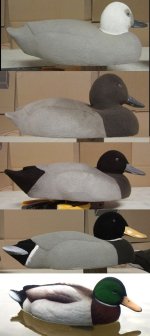
William and I bounce ideas off each other all the time and techniques and supplies are ever changing, improving. We were like everyone else regarding flocking, you know, it's too fragile, it doesn't do anything, it's a gimmick. I only tried it because someone gave me a kit for free. I knew we had to figure out a way to make it work. I told my son after that first hunt and the flocking was coming off when we got home that we will figure this out or I'll flock decoys before every trip if I have to, it made that much difference.
If you do a good job of recovery and buy your supplies in bulk, the cost per decoy is under a dollar. If you slot bag your decoys and give them reasonable care they will last a long time. I have decoys that are still sound after 10 years. They clean up with oxyclean if they are dirty, blood comes out with hydrogen peroxide spray I get at walmart. Usually a simple rinse after a hunt or two is good enough. I'm really liking the scotch guard application, it really made my 5 year old black ducks bold again. It's always pained me the way people trash their decoys, think they aren't that critical when I think if you use them right and take care of your tools the benefits are undeniable. William was my tester, he put the flocking to the test, he is a prove it kind of guy. I'm not terribly careful with my decoys, but I also don't throw them up on the rocks or put them in a common bag. I also never feel the need to put out those 200 decoy spreads like I used to, so my work load is far less. It is definitely hard at first to have the confidence to only use a dozen decoys or less until you figure out you just shot 4 limits with 3 decoys.
Step 1. Gloss oil based enamel over the entire decoy except the eyes.
Step 2. As soon as you have applied the paint, sift flocking over the entire surface.
Step 3. After a day of drying, apply another coat of paint according to your final color coverage over the single flocked surface covering it thoroughly.
Step 4. Sift your final flocking color over that second coat of paint.
Additional clarification of the steps.
Step 1. this coat needs to be thorough, but not quite to the point of running. I use rustoleum gloss oil based enamel or Ace Hardware brand which is likely the same source. The flocking needs to be applied immediately after the paint, gloss stays tacky for awhile, but the sooner the better for good adhesion. I have used all the common flocking adhesives, even the ones provided in the flocking kits and nothing works as well as oil based enamel. My very first flocking attempt was with a kit of black that I used on 3 goldeneye, the flocking was coming off on the way home, however we decoyed hundreds of mallards into those three decoys that day right to the water. The magic of black flocking. Sorry I'm a diver hunter lol.
Step 2. I apply flocking with a simple kitchen sieve. I've tried the puff bottles and the air assist guns and nothing is as fast or thorough as the kitchen sieve over a catch tub. I have a paint booth that I do my flocking in, the air flow is relatively low, so it doesn't pull the flocking out of the area aggressively. Most of it will drift back into my tub and recaptured. I cover the entire decoy with the side up I'm concentrating on so when I'm shaking the decoy, I'm shaking it on, not shaking it off. Once I've done the whole decoy, I shake it aggressively and set it aside.
Step 3. The second coat of is a bit different. It will take more paint and flocking. You want to paint the flocked surface thoroughly but not crazy thick, you need to see the fibers evenly in the paint like the wigeon in the previous post. This is where you determine your final base colors for the decoy.
Step 4. When I flock on the second round. I bump and walk the flocking over the decoy after it's sifted to settle the flocking in. Even after this you will see some glossy showing through, especially on dark colors, just make sure the flocking is covering all areas. When you bump the bottom of the decoy the flocking will walk across the surface filling as it goes, typically going toward where you bump, this is especially true on big goose sized decoys. At that point I'll vigorously shake the decoy to reclaim the excess into the tub. In just 10 minutes that visible gloss showing through will go away.
This is a photo sequence of a mallard. gray over gray on the body first coat of paint and flocking. There is a second coat of gray from the back edge of the chest to the end of the tertials and femoral tract. The second coat on the chest is brown over brown and includes the first coat on the head. The next step is applying black over black to the remaining areas of single coat, the head and the entire rump including the tail. Hand paint the white and airbrush.

William and I bounce ideas off each other all the time and techniques and supplies are ever changing, improving. We were like everyone else regarding flocking, you know, it's too fragile, it doesn't do anything, it's a gimmick. I only tried it because someone gave me a kit for free. I knew we had to figure out a way to make it work. I told my son after that first hunt and the flocking was coming off when we got home that we will figure this out or I'll flock decoys before every trip if I have to, it made that much difference.
If you do a good job of recovery and buy your supplies in bulk, the cost per decoy is under a dollar. If you slot bag your decoys and give them reasonable care they will last a long time. I have decoys that are still sound after 10 years. They clean up with oxyclean if they are dirty, blood comes out with hydrogen peroxide spray I get at walmart. Usually a simple rinse after a hunt or two is good enough. I'm really liking the scotch guard application, it really made my 5 year old black ducks bold again. It's always pained me the way people trash their decoys, think they aren't that critical when I think if you use them right and take care of your tools the benefits are undeniable. William was my tester, he put the flocking to the test, he is a prove it kind of guy. I'm not terribly careful with my decoys, but I also don't throw them up on the rocks or put them in a common bag. I also never feel the need to put out those 200 decoy spreads like I used to, so my work load is far less. It is definitely hard at first to have the confidence to only use a dozen decoys or less until you figure out you just shot 4 limits with 3 decoys.
Thanks so much for the writeup. I'm gonna order the flock this weekend. FWIW I'd rather shoot divers than puddlers any day. The only reason I spend time in the marsh is for the dog. It's tough on a dog in the open water. BTW, if you want to demonstrate what black flock can really do, make a rig of scoters (coots to us old farts). I bet they'd be a home run.
funny you should bring that up. I did make a production coot pattern, but haven't made it yet. I made the coot design for tanglefree and bought a half dozen of them and flocked them, no, I didn't get any for free, but I never floated them before selling them. I'm working on some scoters right now, white wing, surf and black. They do shoot the occasional scoter here on the snake river, but I really just kind of like the black, wouldn't hurt. I get requests for scoters on a regular basis.
get your flocking from Flocking Unlimited, there is a huge difference in quality. By the pound they are a dollar cheaper a pound than amazon and no additional shipping. The stuff on amazon isn't great.
Around here the mallards tend to congregate around the flooded corn and clubs. I probably couldn't shoot a limit of mallards if I shot everyone I saw on a given day. We have a huge variety of species here and as an old taxidermist and wildlife artist I like the variety. Our group of 4 shot 9 species of drakes on one day of a 4 man limit. Our hunts always start with going after the 7 drake, 7 species, but always ends up short of the all drake thing, usually finishing on goldeneye drakes that start pouring in around 11am. That one day was special, most of the time we will have a lot of ringers or bluebills, others will be dominated by redheads or wigeons. On that great day we shot drakes of shoveler, mallard, wigeon, green winged teal, common goldeneye, bluebill, redhead, canvasback, and wood duck.
get your flocking from Flocking Unlimited, there is a huge difference in quality. By the pound they are a dollar cheaper a pound than amazon and no additional shipping. The stuff on amazon isn't great.
Around here the mallards tend to congregate around the flooded corn and clubs. I probably couldn't shoot a limit of mallards if I shot everyone I saw on a given day. We have a huge variety of species here and as an old taxidermist and wildlife artist I like the variety. Our group of 4 shot 9 species of drakes on one day of a 4 man limit. Our hunts always start with going after the 7 drake, 7 species, but always ends up short of the all drake thing, usually finishing on goldeneye drakes that start pouring in around 11am. That one day was special, most of the time we will have a lot of ringers or bluebills, others will be dominated by redheads or wigeons. On that great day we shot drakes of shoveler, mallard, wigeon, green winged teal, common goldeneye, bluebill, redhead, canvasback, and wood duck.
That's an impressive diversity of birds. Shooting several species of divers, plus wood ducks. Can't say I've done that.funny you should bring that up. I did make a production coot pattern, but haven't made it yet. I made the coot design for tanglefree and bought a half dozen of them and flocked them, no, I didn't get any for free, but I never floated them before selling them. I'm working on some scoters right now, white wing, surf and black. They do shoot the occasional scoter here on the snake river, but I really just kind of like the black, wouldn't hurt. I get requests for scoters on a regular basis.
get your flocking from Flocking Unlimited, there is a huge difference in quality. By the pound they are a dollar cheaper a pound than amazon and no additional shipping. The stuff on amazon isn't great.
Around here the mallards tend to congregate around the flooded corn and clubs. I probably couldn't shoot a limit of mallards if I shot everyone I saw on a given day. We have a huge variety of species here and as an old taxidermist and wildlife artist I like the variety. Our group of 4 shot 9 species of drakes on one day of a 4 man limit. Our hunts always start with going after the 7 drake, 7 species, but always ends up short of the all drake thing, usually finishing on goldeneye drakes that start pouring in around 11am. That one day was special, most of the time we will have a lot of ringers or bluebills, others will be dominated by redheads or wigeons. On that great day we shot drakes of shoveler, mallard, wigeon, green winged teal, common goldeneye, bluebill, redhead, canvasback, and wood duck.
I've been browsing the Flocking Unlimited site. I'll order some this weekend. Thanks again.
You guys are a bad influence. Five pounds of flock and a sieve are on the way from Flocking Unlimited. One pound each in five colors. I'll probably end up getting more flock on myself than the decoys. First up as test dummies will be some old plastics.
@SJ Fairbank we were helping a young man getting started on flocking, and he kept posting on how it wasnt spreading very far and how expensive flocking was. I made youtube videos showing how we do the second coat of flocking and how how the sieve is used to spread the flocking. You can see in my video with simple shakes, it just rains down with very little effort. We finally narrowed it down to his sieve and how hard he was having to shake to get material to come through. The dollar store, single wire sieve is the absolute best for flocking. If you get a sieve with multiple wires and finer holes, you will have issues. Honest to god, the cheaper the sieve is (price wise) the better its been for my flocking experience. I have a sieve for every color flocking bin so that way I dont have to move one over to another bin when doing different colors on a bird.You guys are a bad influence. Five pounds of flock and a sieve are on the way from Flocking Unlimited. One pound each in five colors. I'll probably end up getting more flock on myself than the decoys. First up as test dummies will be some old plastics.
These videos are from when I first first started doing decoys and I was just making herter remakes out of a decoy unlimited mold. You can see in the second video, how very little shaking I do to get a nice stream of flocking out of the sieve.


